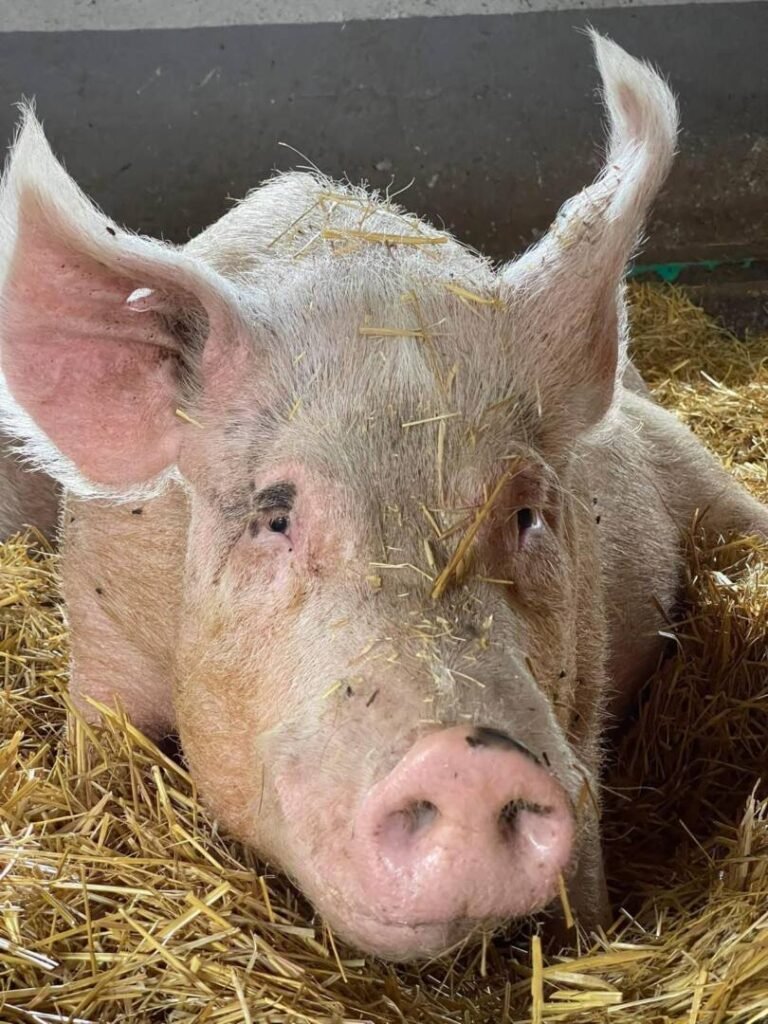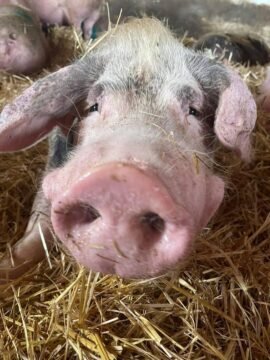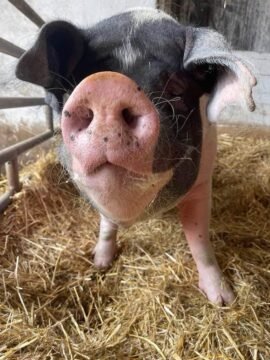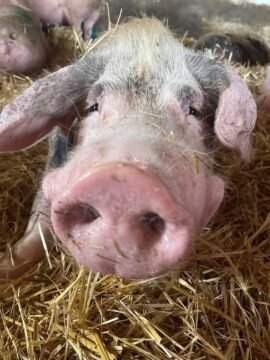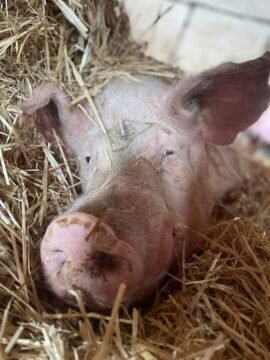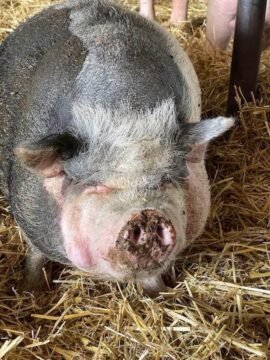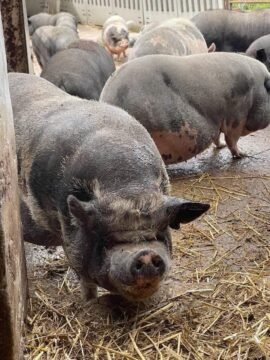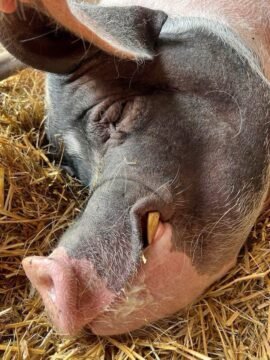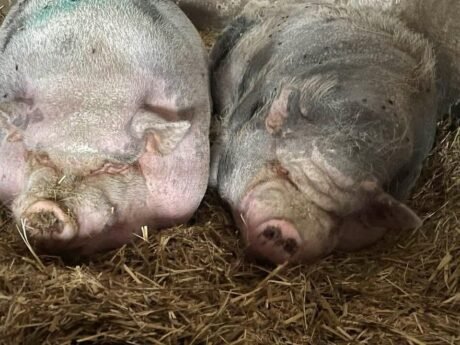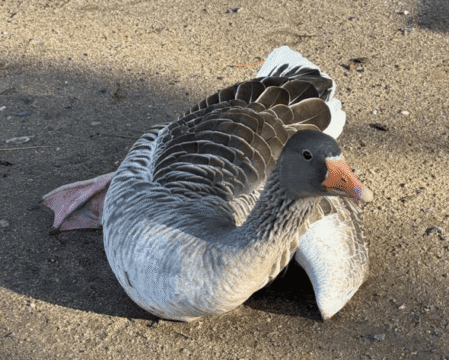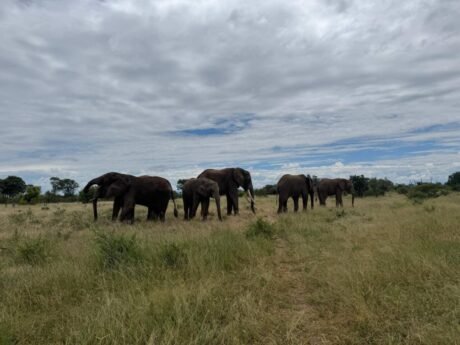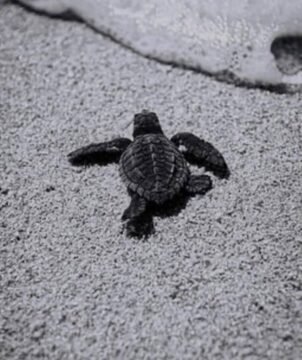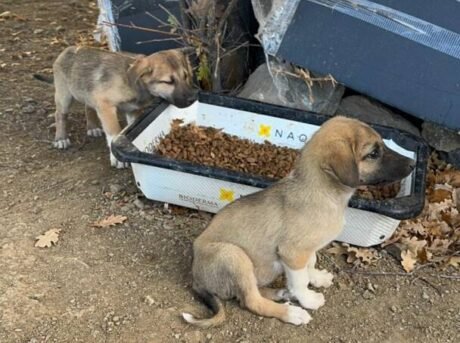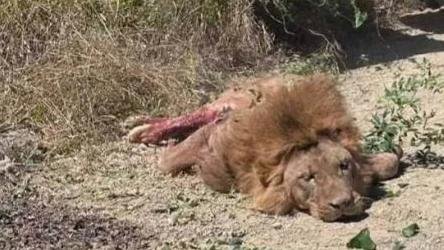Wild at Life e.V. cares for dozens of rescued farm animals — especially pigs — who now live safely with our partner NGO, an organization that provides a home to hundreds of farm animals. Among them are many pigs we saved from truly horrible conditions. Huddled together in a filthy, cramped corner of a slaughterhouse, they were surrounded by piles of rotting waste. The pigs were in clear distress, bearing visible wounds and suffering from severe malnourishment and weakness. Treated like trash and abandoned to suffer in squalor, their situation was devastating. With rescue and care, they are finally safe and can begin to heal. Whenever we have the necessary funds, we extend our efforts to save even more animals from such dire situations, giving them the chance at a life free from suffering.
No Longer Trash: Giving Rescued Pigs a Second Chance
Pigs face various challenges, including factory farming conditions that prioritize efficiency over animal welfare. Many pigs are raised in crowded and unsanitary environments, lacking adequate space, social interaction, and proper care. This can lead to stress, disease, and injury. Additionally, practices like tail docking and teeth clipping are common, often without pain relief. Some farms also confine breeding sows to gestation crates, restricting their movement. These conditions have sparked debates about animal rights and welfare, with many advocating for more humane treatment and better living conditions for pigs.
Large-scale pig farming involves significant ethical issues like overcrowding, poor sanitation, and stress-related diseases, causing pigs to suffer without proper care or comfort. This industry also harms the environment by producing vast amounts of manure laden with nitrates and bacteria, which pollutes waterways and harms communities. Furthermore, pig production contributes to climate change through greenhouse gas emissions from the feed production, animal waste, and the animals themselves, with methane and nitrous oxide being potent gases that contribute to global warming.
Cruelty and Animal Welfare
Overcrowding and Lack of Enrichment:
Millions of pigs are raised in overcrowded, factory-like conditions that cause stress, fighting, and increased vulnerability to disease.
Poor Living Conditions:
Pigs often lack basic comfort, are exposed to feces and flies, and are kept in groups that lead to conflict and injuries.
Lack of Care:
There are instances of pigs being left to die from illness or injury without receiving proper attention.
Environmental Impact and Climate Change
Greenhouse Gas Emissions:
The production of pig feed, primarily corn and soybeans, along with animal waste, releases potent greenhouse gases like methane and nitrous oxide, which are more damaging to the climate than carbon dioxide.
Water Pollution:
The immense quantities of manure produced by pig farms often contain high levels of nitrates and bacteria. When stored in lagoons or spread on fields, these toxins can run off into rivers and streams, polluting water sources and contributing to eutrophication.
Air Quality:
Ammonia levels from pig manure can pose health risks to nearby communities, with some residents reporting asthma and other respiratory issues
For these reason Wild at Life has decided to tackle the issue and started negotiating welfare on the industry and comply with the SDG’s.
How You can Help
A wonderful way to support our work is through a symbolic adoption of one of our rescued pigs, “Lucky Tonizka.” Your adoption would help us provide food, medical care, and safety for him and the many others who rely on us. Every donation — big or small — also makes a huge difference in allowing us to continue rescuing animals from unbearable conditions and giving them the lives they deserve.
Get the full story!
This post refers to one of our projects. Read more about the related project to find out the background of this story.
Spread the news!
Help us increasing social commitment in saving endangered wild species. Express your support by sharing this article in your favorite social media channel.
You may also like...
Every year, we travel to Sri Lanka to care for animals who would otherwise have no help. Our work focuses on stray dogs and cats living on the beaches and in nearby areas we are responsible for. We provide regular
We work with a local Frankfurt-based wildlife charity called Projekt Oase – Mensch und Tier im Einklang e.V., which focuses on protecting and rescuing wild waterfowl and other birds along the Main River. Projekt Oase is a small but passionate
At our sanctuary in Zambia, the team of Wild at Life e.V. has wonderful news to share. Our nine rescued elephants — all survivors of drought or poaching — are thriving, and they continue to enjoy their days in complete
Sea turtles are among the most ancient and extraordinary creatures in our oceans, but today they are facing more threats than ever before. Climate change, habitat destruction, pollution, irresponsible fishing practices, and illegal poaching have all pushed many species to
Every day, our team works tirelessly to care for the hundreds of stray animals living on the outskirts of Ankara. We currently feed between 250–300 dogs daily, ensuring that no one goes hungry — even in the most remote and
A male lion named Zeus escaped from the underground animal park Aslan Diyarı in Antalya’s Manavgat district, attacking and injuring a local farmer, Süleyman Kır, before being captured and killed. Zeus had broken free from his cage at a private
Subscribe to our newsletter to keep up to date with our activities!
